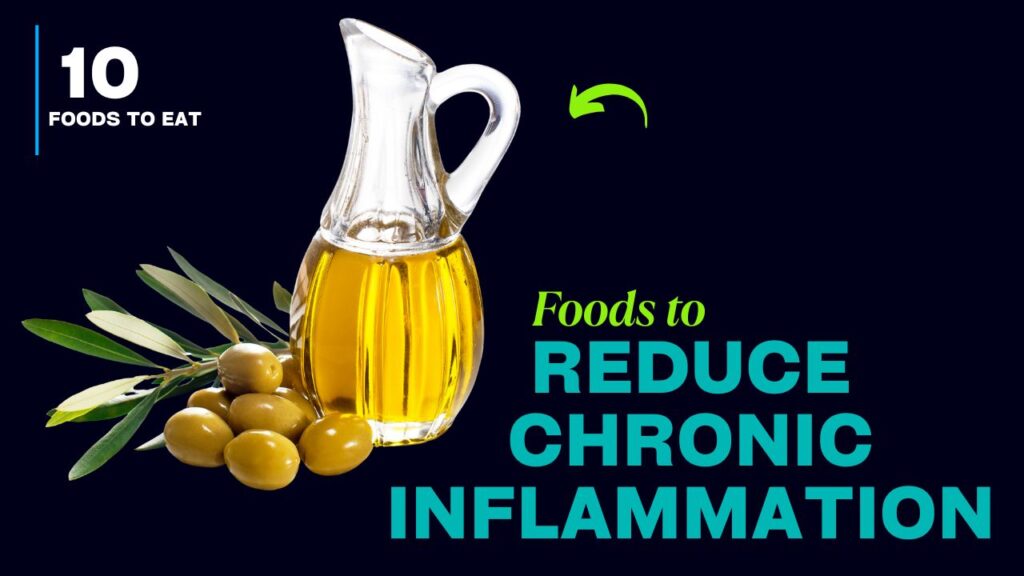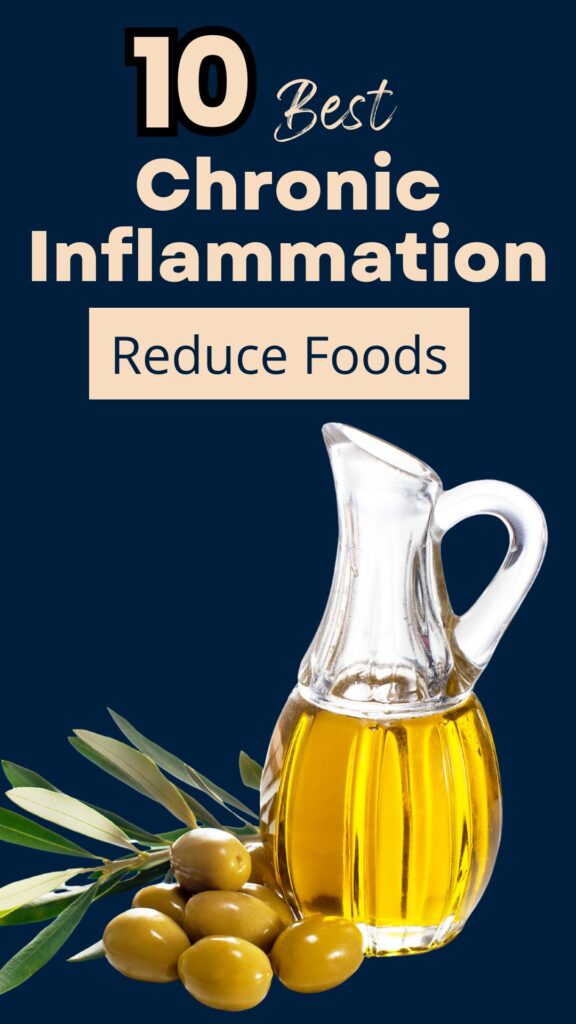Some links in this post are affiliate links. If you make a purchase through these links, I may receive a small commission. This helps support the site at no extra cost to you.
Did you know that chronic inflammation is often called the “silent killer” because it can quietly contribute to diseases like heart disease, diabetes, arthritis, and even cancer without showing early warning signs?
Many people assume inflammation only happens when you sprain an ankle or cut your finger, but the truth is that low-grade, long-term inflammation inside your body can be far more harmful.
The good news? Your diet has a powerful role in reducing inflammation naturally. Studies show that certain foods are packed with antioxidants, phytonutrients, and healthy fats that calm inflammation at its root. On the other hand, sugary drinks, fried foods, and processed snacks can fuel the fire.
In this post, you’ll discover 10 scientifically proven anti-inflammatory foods, along with practical tips on how to eat them, who benefits most, what to avoid, and even storage hacks to keep them fresh.

Table of Contents

Foods To Reduce Chronic Inflamation
1. Fatty Fish (Salmon, Sardines, Mackerel)
Best Ways to Eat or Use It
- Grilled salmon with lemon and herbs.
- Sardines on whole-grain toast.
- Mackerel in Mediterranean-style salads.
- Salmon in sushi rolls or poke bowls.
Tip: Pair fish with leafy greens and olive oil to boost absorption of omega-3 fatty acids.
Who Should Eat / Avoid
- Good for: People with joint pain, athletes for recovery, heart patients.
- Avoid/Limit if: You have fish allergies, or high mercury sensitivity (choose wild-caught salmon over swordfish or tuna).
Storage & Buying Tips
- Buy wild-caught varieties when possible.
- Store fresh fish in the coldest part of your fridge, use within 1–2 days.
- Freeze for up to 3 months if not cooking immediately.
Do’s & Don’ts
| ✅ Do | ❌ Don’t |
|---|---|
| Choose wild-caught fish | Eat fried fish often |
| Store in airtight containers | Refreeze thawed fish |
| Cook with gentle heat (grill, bake) | Overcook until dry |
Possible Side Effects
- Overeating can expose you to trace amounts of mercury. Stick to 2–3 servings per week for balance.
2. Turmeric
Best Ways to Eat or Use It
- Add turmeric to curries, soups, or golden milk.
- Blend into smoothies with black pepper for better absorption.
- Mix in salad dressings or roasted vegetables.
Who Should Eat / Avoid
- Good for: People with arthritis, digestive issues, or inflammatory skin conditions.
- Avoid/Limit if: You are on blood-thinning medications (consult your doctor).
Storage & Buying Tips
- Store turmeric powder in an airtight container, away from light.
- Fresh turmeric root can be kept in the refrigerator for 2–3 weeks.
Do’s & Don’ts
| ✅ Do | ❌ Don’t |
|---|---|
| Pair with black pepper | Take in very high doses |
| Use fresh root for more potency | Store in humid places |
| Add to warm drinks/meals | Ignore possible drug interactions |
Possible Side Effects
- Large amounts may cause stomach upset.
3. Leafy Greens (Spinach, Kale, Swiss Chard)
Best Ways to Eat or Use It
- Fresh salads with olive oil.
- Blend into green smoothies.
- Lightly sauté with garlic.
- Add to soups and omelets.
Who Should Eat / Avoid
- Good for: Weight-loss seekers, people with high blood pressure, those needing more fiber.
- Avoid/Limit if: You have kidney stones (high oxalate content in spinach).
Storage & Buying Tips
- Choose crisp, dark green leaves.
- Store in a breathable bag in the fridge.
- Use within 3–5 days for freshness.
Do’s & Don’ts
| ✅ Do | ❌ Don’t |
|---|---|
| Wash before eating | Leave wet (leads to spoilage) |
| Eat raw or lightly cooked | Overcook (destroys nutrients) |
| Combine with vitamin C foods | Store next to ethylene-producing fruits |
Possible Side Effects
- Overeating raw spinach may interfere with calcium absorption.
4. Berries (Blueberries, Strawberries, Raspberries)
Best Ways to Eat or Use It
- Fresh as a snack.
- In oatmeal or yogurt bowls.
- Blended into smoothies.
- Mixed into salads with nuts.
Who Should Eat / Avoid
- Good for: Brain health, heart health, immune support.
- Avoid/Limit if: You have a berry allergy.
Storage & Buying Tips
- Choose firm, brightly colored berries.
- Store in a single layer in the fridge.
- Wash only before eating to prevent mold.
Do’s & Don’ts
| ✅ Do | ❌ Don’t |
|---|---|
| Eat fresh or frozen | Leave wet in storage |
| Add to yogurt/grains | Store in sealed plastic bags |
| Choose organic if possible | Expose to direct sunlight |
Possible Side Effects
- Too much can lead to stomach upset due to high fiber.
5. Olive Oil (Extra Virgin)
Best Ways to Eat or Use It
- Drizzle over salads.
- Use as a base for dressings.
- Add to roasted vegetables.
- Light sautéing (avoid deep frying).
Who Should Eat / Avoid
- Good for: Heart patients, people with high cholesterol, weight-watchers (in moderation).
- Avoid/Limit if: You need to restrict fats strictly.
Storage & Buying Tips
- Store in a cool, dark place.
- Choose dark glass bottles.
- Avoid plastic containers.
Do’s & Don’ts
| ✅ Do | ❌ Don’t |
|---|---|
| Use extra virgin for salads | Use for deep frying |
| Store away from heat | Buy in large plastic jugs |
| Check harvest date | Leave uncapped |
Possible Side Effects
- Overconsumption may lead to excess calories.
6. Green Tea
Best Ways to Eat or Use It
- Brew hot or iced green tea.
- Use matcha powder in smoothies or lattes.
- Pair with lemon to boost antioxidants.
Who Should Eat / Avoid
- Good for: Students, professionals (mental focus), heart and liver health.
- Avoid/Limit if: Sensitive to caffeine, pregnant women (limit intake).
Storage & Buying Tips
- Keep tea leaves in airtight tins.
- Avoid moisture and sunlight.
Do’s & Don’ts
| ✅ Do | ❌ Don’t |
|---|---|
| Brew at 80°C (not boiling) | Use boiling water (destroys flavor) |
| Drink fresh | Reuse old leaves multiple times |
| Combine with lemon | Over-sweeten with sugar |
Possible Side Effects
- Too much caffeine can cause jitters or insomnia.
7. Nuts (Walnuts, Almonds)
Best Ways to Eat or Use It
- Handful as a snack.
- Add to oatmeal or salads.
- Blend into nut butter.
Who Should Eat / Avoid
- Good for: Diabetics, athletes, brain health.
- Avoid/Limit if: You have nut allergies.
Storage & Buying Tips
- Store in airtight jars in a cool place.
- Refrigerate to prevent rancidity.
Do’s & Don’ts
| ✅ Do | ❌ Don’t |
|---|---|
| Eat raw or lightly roasted | Eat salted, processed nuts often |
| Store properly | Leave exposed to air |
| Mix with dried fruits | Eat in excess (calorie-dense) |
Possible Side Effects
- High in calories; moderation is key.
8. Garlic
Best Ways to Eat or Use It
- Fresh minced in sauces.
- Roasted garlic spread.
- Stir-fried with veggies.
Who Should Eat / Avoid
- Good for: Immune system, cholesterol management.
- Avoid/Limit if: You’re on blood-thinning medication.
Storage & Buying Tips
- Store whole bulbs in a cool, dry place.
- Avoid refrigerating peeled garlic.
Do’s & Don’ts
| ✅ Do | ❌ Don’t |
|---|---|
| Use fresh cloves | Store peeled in the fridge long term |
| Add at the end of cooking | Burn garlic (bitter taste) |
| Crush for maximum benefits | Buy pre-chopped garlic in oil often |
Possible Side Effects
- Can cause bad breath or stomach upset in excess.
9. Tomatoes
Best Ways to Eat or Use It
- Fresh in salads.
- Tomato soup.
- Cooked sauces (boosts lycopene).
Who Should Eat / Avoid
- Good for: Skin health, men’s prostate health, heart patients.
- Avoid/Limit if: You have acid reflux.
Storage & Buying Tips
- Store at room temperature until ripe.
- Keep away from direct sunlight.
Do’s & Don’ts
| ✅ Do | ❌ Don’t |
|---|---|
| Pair with olive oil | Refrigerate unripe tomatoes |
| Eat both raw and cooked | Eat green tomatoes raw |
| Choose bright red, firm ones | Store near bananas/apples |
Possible Side Effects
- Excess can cause acidity.
10. Ginger
Best Ways to Eat or Use It
- Fresh ginger tea.
- Grated in stir-fries.
- Smoothies or detox drinks.
Who Should Eat / Avoid
- Good for: Nausea relief, digestion, muscle pain.
- Avoid/Limit if: On blood-thinners or if you have gallstones.
Storage & Buying Tips
- Store fresh root in fridge wrapped in paper towel.
- Freeze for longer storage.
Do’s & Don’ts
| ✅ Do | ❌ Don’t |
|---|---|
| Use fresh grated ginger | Eat in excessive amounts |
| Add to tea or stir-fries | Store in plastic bags (causes mold) |
| Peel only when needed | Leave unwrapped in fridge |
Possible Side Effects
- Too much can cause heartburn.
Conclusion
Chronic inflammation doesn’t always show visible signs, but it slowly impacts your health over time. By adding foods like fatty fish, turmeric, leafy greens, berries, olive oil, and more, you can naturally calm inflammation, boost your immune system, and protect against chronic diseases.
Small dietary changes—like replacing processed snacks with nuts, swapping sugary drinks for green tea, or cooking with olive oil instead of refined oils—make a big difference.
Now it’s your turn: Which of these anti-inflammatory foods will you add to your next meal? Share your favorite recipe or food pairing in the comments!
Frequently Asked Questions (FAQs)
What are the best foods to reduce inflammation quickly?
Some of the fastest-acting anti-inflammatory foods include fatty fish (rich in omega-3s), turmeric, ginger, berries, and green tea. These contain compounds that help lower inflammation markers in the body.
Are bananas anti-inflammatory?
Yes, bananas have anti-inflammatory properties thanks to their antioxidants and potassium. They may not be as strong as berries or turmeric, but they still support gut health and reduce inflammation.
Can coffee reduce inflammation?
In moderation, coffee may help reduce inflammation due to its antioxidants. However, excessive intake (more than 3–4 cups daily) can trigger stress responses and stomach issues that may worsen inflammation.
What foods should I avoid if I have chronic inflammation?
Avoid sugary drinks, fried foods, processed snacks, refined carbs, and red/processed meats. These can fuel inflammation and increase the risk of chronic diseases.
How often should I eat anti-inflammatory foods?
You don’t need to eat all of them daily. Instead, aim to include a variety throughout the week—for example, fatty fish 2–3 times weekly, daily leafy greens, berries a few times a week, and spices like turmeric/ginger in meals or drinks.
Do anti-inflammatory foods help with arthritis pain?
Yes, many studies show that omega-3-rich fish, turmeric, ginger, and leafy greens can reduce joint pain and stiffness in arthritis patients by lowering inflammation in the body.
Is it possible to completely eliminate inflammation with diet?
No, you cannot completely eliminate inflammation because your body needs it in small amounts for healing. The goal is to reduce chronic low-grade inflammation that harms long-term health. A balanced anti-inflammatory diet helps achieve that.
Are all oils bad for inflammation?
Not all oils are harmful. Extra virgin olive oil, avocado oil, and flaxseed oil are anti-inflammatory, while refined vegetable oils and trans fats are pro-inflammatory.
Can children eat anti-inflammatory foods too?
Yes, children benefit from eating berries, leafy greens, nuts (if no allergies), olive oil, and fish. It supports their growth, immunity, and brain development. Always adjust portion sizes based on age.










